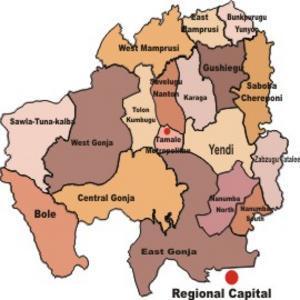Advertisement
Published: October 3rd 2006

 The Northern Region
The Northern Region
Copied from the Tourist Ghana websiteDesiba! As I am getting into the “regular” routine of going to work, I know that I will be leaving the office and staying in a district in the Northern region. It will only be a couple weeks until I move for 3-4 months to the district of choice, commuting back to Tamale as required. I will be working with the Planning Officer and doing capacity building in the District, as well as documenting the current process and using it as a model or pilot district.
“Northern Region Poverty Reduction Programme (NORPREP) seeks to improve the livelihoods and living conditions of poor rural communities with emphasis on woman and other vulnerable groups though deepening and broadening rural services, community and individual self-help capacity.”
NORPREP is a program of the government at the Regional Level (only currently in the northern region of Ghana) which goal is to increase the decentralization of the Government of Ghana (GOG). I will work in partnership with NORPREP and the Regional Coordinating Council (RCC) at the District level with the Planning Unit. This is a lot to take in. Let me explain the government briefly:
6) Ministry of Local Government and Rural Development (MLGRD)
- this the central government in Accra (the capital) which NORPREP would fall under
7) Regional Coordinating Council (RCC) - they are responsible for all the activities in their respective regions. The northern region consists of 18 Districts with a population of 2 million (with only 400,000 in the urban area, the remaining in the rural areas). They report to the MLGRD.
8) The District Assembly (DA) - is the governing body at the District level. A district has a district capital and includes the surrounding villages. These districts are quite large in the North and are considered the most deprived in Ghana (along with Upper West and Upper East Regions)
a. Some key members of the District Coordinating and Planning Unit
i. District Chief Executive
ii. District Coordinating Director
iii. District Finance Officer
iv. District Planning Officer/ District Budget Officer
v. Extended DPCU (heads of decentralized departments)
9) The Area Council - reports to the DA what the community members want consolidated from the Unit committees findings. The AC is made up of volunteer members who are elected or appointed and currently is not a paid position due to lack of funds.
10) The Unit Committee - This committee
is responsible for gathering information at the Community level and are elected or nominated. They again are not paid positions. They are supposed to be the connection to the community.
So with all this in mind the process is supposed to work by the Communities problems being recorded by the Unit Committees work in the community through participatory methods to collect the information. This information is prioritized (by the community) and than passed to the Area Council who consolidates all the Unit Committees responses and presents it to the District Assembly. The DA then can make a plan and allocate funding or NGO/CBO programs to the requirements of the communities. This is all ideal.
My position will to be to figure out what is not working at any of these levels from the Unit Committees to the District Assembly. Hopefully capacity building at this level will improve the lives of the rural poor and fall in line with NORPREPs objectives as well as my own.
The direction of the project at this initial stage is taking form in terms of capacity building with the core DPCU (which includes the Coordinating Director, Finance, Planner and Budgeter) in the

 East Gonja
East Gonja
My new District Capitalarea of computers. With computer training it will become easier to prepare plans and budget on the computer, which is a requirement for the government. The current status of computer knowledge at the District Assemblies is quite basic.
Advertisement
Tot: 0.076s; Tpl: 0.018s; cc: 6; qc: 51; dbt: 0.0441s; 1; m:domysql w:travelblog (10.17.0.13); sld: 1;
; mem: 1.1mb

 The Northern Region
The Northern Region
 East Gonja
East Gonja